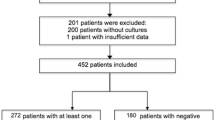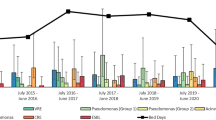Abstract
Burns cause a loss of skin barrier function, rendering it prone to infection. The prevention of infection comprises a focus on the treatment of patients with burns. Therefore, we analysed the results of microbiological tests of patients with severe and extremely severe burns to provide a basis for the prevention and treatment of infection in patients with burns. The results of microbiological tests of patients with severe and extremely severe burns admitted to our burn centre between 2009 and 2019 were retrospectively reviewed. The overall positive rate of microbial detection was 40.67% and did not significantly decline over the 10-year study period. The most common positive sites were wounds, sputum, and urine. The most common bacterial species causing the infections were Acinetobacter baumannii, Klebsiella pneumoniae, and Pseudomonas aeruginosa. Furthermore, the predictors of a positive detection, overall and at various sites, mainly included the burn area and depth, inhalation injury, and length of the hospital stay. Positive detection was an important predictor of the prognosis. In particular, a positive blood culture and Klebsiella pneumoniae had better predictive strength for mortality than other sites and strains. This study analysed the microbiological testing results at a single burn centre over a period of 10 years. The results provide information regarding the predictors of a positive detection and the influence of a positive detection on prognosis, and can be used as a basis for the development of clinical infection prevention and treatment strategies, as well as the selection of treatment measures.

Similar content being viewed by others
Abbreviations
- TBSA:
-
Total body surface area
References
Bahçe ZŞ, Öztaş T (2020) Epidemiological analysis of patients with burns in third-line hospitals in Turkey. Int Wound J17:1439–1443
Forbinake NA, Ohandza CS, Fai KN et al (2020) Mortality analysis of burns in a developing country: a CAMEROONIAN experience. BMC Public Health 20:1269
Vagholkar K, Hariharan N, Vagholkar S (2021) Factors affecting mortality in burns: a single center study. Int Surg J 8:78–85
Yang A, Yassin M, Phan T (2021) Vibrio mimicus wound infection in a burn patient. Radiol Case Rep 16:1348–1351
Noskiewicz J, Juszczak P, Rzanny-Owczarzak M et al (2019) Antibiotic therapy and infection complications in paediatric burn injuries. Adv Hyg Exp Med 73:1–8
Pham TN, Neff MJ, Simmons JM et al (2007) The clinical pulmonary infection score poorly predicts pneumonia in patients with burns. J Burn Care Res 28:76–79
Glik J, Kawecki M, Gaździk T et al (2012) The impact of the types of microorganisms isolated from blood and wounds on the results of treatment in burn patients with sepsis. Pol J Surg 84:6–16
Sharma BR (2007) Infection in patients with severe burns: causes and prevention thereof. Infect Dis Clin N Am 21:745–759
Gholipourmalekabadi M, Bandehpour M, Mozafari M et al (2015) Decellularized human amniotic membrane: more is needed for an efficient dressing for protection of burns against antibiotic-resistant bacteria isolated from burn patients. Burns 41:1488–1497
Olmedo GM, Cerioni L, Sepulveda M et al (2018) Polyhexamethylene guanidine as a fungicide, disinfectant and wound protector in lemons challenged with Penicillium digitatum. Food Microbiol 76:128–134
Fukuda K, Sato Y, Ishihara M et al (2020) Skin cleansing technique with disinfectant using improved high-velocity steam-air micromist jet spray. Biocontrol Sci 25:35–39
Soltani M, Ravine TJ, Davis JH Jr (2021) Novel boronium salt exhibits substantial antibacterial activity when compared to a commercial quaternary ammonium disinfectant. Bioorg Med Chem Lett 36:127808
Georgieva D, Koleva G, Hristova I et al (2020) Effect on skin microflora in hygienic bathing of patients with chlorhexidine gluconate disinfectant and non-rinse product. Health Sci J 14:708
Al-Haddad AM, Udo EE, Mokadas EM et al (2001) Persistence of a clone of methicillin-resistant Staphylococcus aureus in a burns unit. J Med Microbiol 50:558–564
Konvalinka A, Errett L, Fong IW (2006) Impact of treating Staphylococcus aureus nasal carriers on wound infections in cardiac surgery. J Hosp Infect 64:162–168
Chen MC, Chen MH, Wen BS et al (2014) The impact of inhalation injury in patients with small and moderate burns. Burns 40:1481–1486
Chen J, Yan H, Luo G et al (2013) Characteristics of burn deaths from 2003 to 2009 in a burn center: a retrospective study. Burns Trauma 1:80–86
Acknowledgements
The authors thank all the doctors of the burn department of the First Affiliated Hospital of Naval Medical University and acknowledge their immense dedication in providing the first line of clinical care and treatment of a vast number of patients with major burns.
Funding
This research was supported by the Hangzhou Medical and Health Science and Technology project (Grant/award number: B20200432), the National Natural Science Foundation of China Youth Award (Grant/award number: 81401596), and the National Natural Science Foundation of China (Grant/award number: 81772125 and 81701899).
Author information
Authors and Affiliations
Corresponding authors
Ethics declarations
Conflict of interest
The authors declare that there are no potential conflicts of interest.
Research involving human participants and/or animals
This study is a retrospective case analysis, only involving case text and data analysis, not involving human and animal.
Informed consent
Informed consent is not involved in this study.
Additional information
Publisher's Note
Springer Nature remains neutral with regard to jurisdictional claims in published maps and institutional affiliations.
Rights and permissions
About this article
Cite this article
Jian, J., Yu, P., Zheng-Li, C. et al. Epidemiological retrospective analysis in major burn patients: single centre medical records from 2009 to 2019. Updates Surg 74, 1453–1459 (2022). https://doi.org/10.1007/s13304-021-01215-z
Received:
Accepted:
Published:
Issue Date:
DOI: https://doi.org/10.1007/s13304-021-01215-z




